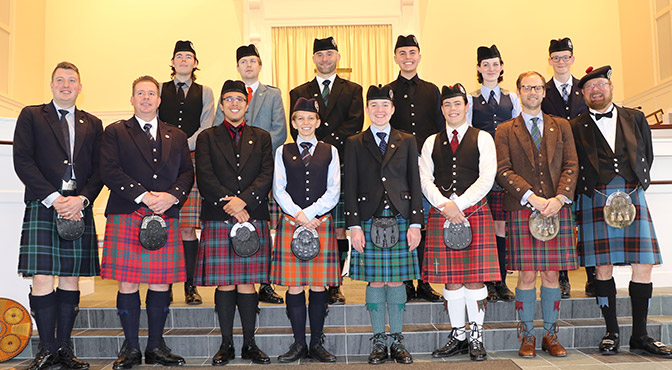At 9:30 am on October 7, 2017, the Nicol-Brown Invitational began again for a remarkable 35th time. The contest, originally envisioned by American piping patriarch Donald Lindsay, aims to give top amateur pipers from North America a first-class venue to showcase their talent.
In doing so, it also provides a taste of the high pressure, indoor competition environment that many of them will need to master should they continue on to the upper echelons of solo piping. It was a great honor to be asked to judge the contest ten years after I had last attended, that time as a competitor.
I was joined by two other Nicol-Brown alumni, Ian K. MacDonald of Ontario and Andrew Lee of British Columbia. Both Ian and Andrew gave a recital the night before, but I was unable to attend due to work commitments. I hear that they both played wonderfully and I am sad that I missed it. This was the first time that all of the judges of the event were former competitors; it will surely not be the last. Such is the quality of players who have and will continue to grace this stage.
We started off with the 6/8 March competition for the Donald MacLeod Silver Buckle. The ten pipers each played two 6/8s of their own choosing, and all did so with great accord. Pipes were generally bright and well-tuned, making our job as judges all the more difficult. One trend we did notice however was that many competitors were playing their marches too fast and round, much like a Grade 1 band would. While this style of 6/8 playing makes for exciting band playing, we as judges felt that the competitors who played at a more relaxed tempo and with greater expression were able to better capture the 6/8 idiom. Alistair Bevan ended up with the top prize, playing a relaxed and swinging rendition of “Cameron MacFadyen” and “Mrs. Lily Christie.”
[wds id=”6″]
After an intermission for the annual photograph and lunch, we began the piobaireachd competition for the Nicol-Brown Chalice around 1 pm. Once again, the judges and audience were treated to ten good performances; it was clear that the competitors were well rehearsed, as most presented very mature and well-rounded interpretations of their tunes. Some players had a bit of trouble getting their pipes perfectly locked in the high-ceilinged sanctuary of the church, but in general, pipes were solid throughout.
Some performances of note included Laureano Thomas-Sanchez’s beautifully expressed “Lament for the Earl of Antrim” (First Prize), Alistair Bevan’s mature presentation of “The Groat” (Second Prize), and Ben Montross’s performance of “Lament for Captain MacDougall” on a pristine bagpipe (Third Prize). There really wasn’t a bad performance in the group and it made for a very enjoyable afternoon as a judge.
Finally, after a short break, we came to the final event of the day: the March, Strathspey and Reel competition for the William Ross Targe. Attendees were once again treated to an excellent show. The playing was generally up-tempo and lively all around. It was Alistair Bevan who took first prize, as his mature and steady playing on an excellent pipe left the judges with very little to criticize. Rounding out the top three were Tori Killoran, who played a very musical set, and Laureano Thomas-Sanchez, whose choice to play “The Cameronian Rant” and the eight-part “Smith of Chilliechassie” was impressive if not a bit ambitious. I have to mention that once again, the level of playing was strong across the board. Most of the performances would not have been out of place in a professional contest.
After the prize-giving ceremony, we all returned to the host hotel for a celebratory dinner. Activities like the group dinner, the pre-contest recital, and the post-contest master class really make this event feel special. The weekend is more of a celebration of these young players’ accomplishments rather than strictly a cutthroat bagpipe competition. Contest organisers Paula Glendinning, Donald Lindsay, Barb McCarthy, and many others do everything they possibly can to make the competitors feel welcome and to come away from the weekend having learned valuable lessons and feeling inspired to take their playing to the next level.
If we pipers say that we use competition as a means of improving our idiom, then it is hard to think of many other contests anywhere in the world that do more to accomplish that goal than this one. Of course, the Argyllshire Gathering and Northern Meeting serve as points of inspiration for our very best, but for young players in North America, no contests are more revered than the Nicol-Brown and its Canadian peer, the George Sherriff Invitational. The goal of gaining one of the coveted invitations drives many players to succeed during the season, and the experience playing here teaches them that they can play at a high-level anywhere.
Sitting behind the bench this year, ten years after I had last played here, I couldn’t help but think how important this contest was to me, and so many other pipers from North America. The competitive success of so many players who have played here is proof that the Nicol-Brown is achieving its goal. It was an honor to be back to judge the contest this year, and I encourage all who can to attend and support the contest in future years. We are fortunate to have it.
• More on this contest here.
[wds id=”3″]
